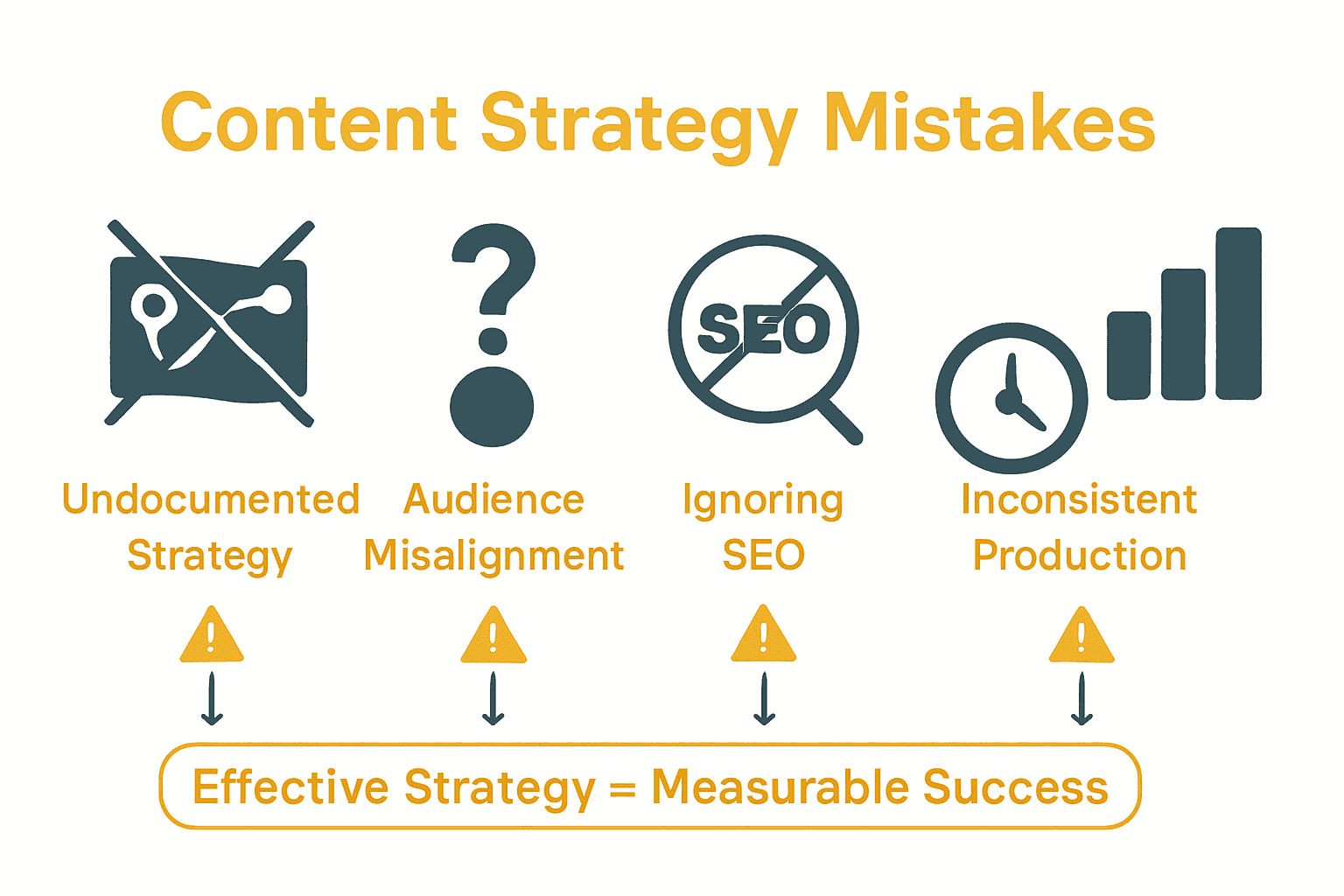Content Strategy Explained: Boosting Business Success
- Eddie The Chef

- Nov 6
- 7 min read

Most brands waste time and money on content that never delivers results. In fact, over 60 percent of marketers lack a documented content strategy, which means their blogs and posts often miss the mark. A clear content strategy now separates businesses that get noticed from those that simply add to the noise. If you want your marketing to connect with real people and drive meaningful growth, understanding how to build and execute a modern content strategy is crucial.
Table of Contents
Key Takeaways
Point | Details |
Content Strategy Definition | A content strategy is a structured approach that aligns content creation with business goals and audience needs, moving beyond mere volume to strategic relevance. |
Critical Elements of Effective Planning | Successful content planning involves understanding the audience, aligning goals, conducting a content audit, and establishing a clear content calendar. |
Multi-channel Implementation | Consistent brand messaging and platform-specific optimization are essential in creating an integrated content experience across multiple channels. |
Common Mistakes to Avoid | To ensure effectiveness, avoid undocumented strategies, audience misalignment, and neglecting performance tracking, which can undermine overall content strategy success. |
Defining Content Strategy In Modern Marketing
A content strategy is more than just creating random articles or social media posts. It’s a deliberate, structured approach to planning, developing, and managing content that aligns with specific business objectives and resonates with target audiences. According to ADMA, content marketing strategy drives engagement by mapping content creation processes directly to customer lifecycle and brand storytelling.
At its core, a robust content strategy involves several critical components that transform disconnected content into a powerful marketing tool. These include audience persona development, keyword research, content mapping, and continuous performance evaluation. Article Writers Australia emphasizes that a documented strategy reduces inefficient marketing expenditures by providing a clear roadmap for content creation and ensuring each piece serves a specific strategic purpose.
The modern content strategy isn’t just about volume but strategic relevance. Successful businesses understand that content must do more than exist - it must connect, inform, and drive action. This means creating content that:
Addresses specific audience pain points
Aligns with buyer journey stages
Supports broader marketing and sales objectives
Demonstrates genuine expertise and value
By treating content as a strategic asset rather than a tactical afterthought, businesses can transform their digital presence from noise to meaningful conversation. The Ultimate Business Marketing Strategy Recipe explores how regional businesses can leverage targeted content to build authentic connections and drive sustainable growth.
Types Of Content Strategies For Businesses
Businesses today have multiple content strategy approaches to engage their target audiences effectively. CMLabs highlights that modern marketing strategies encompass diverse content types tailored to specific business objectives and audience preferences.
Five primary content strategies emerge as powerful tools for regional Australian businesses:
Here’s a summary of the five primary content strategy types for businesses:
Strategy Type | Main Purpose | Common Formats |
Thought Leadership | Build credibility & trust | In-depth articles Whitepapers Reports |
Educational Content | Solve customer problems | Tutorials How-to guides Webinars |
Storytelling Content | Connect emotionally | Brand narratives Success stories |
Performance-Driven | Drive conversions & sales | Product comparisons Case studies |
Interactive Content | Boost engagement | Quizzes Calculators Surveys |
Thought Leadership Content
Positions brand as industry expert
Includes in-depth articles, whitepapers, research reports
Builds credibility and trust
Educational Content
Solves customer problems
Includes tutorials, how-to guides, webinars
Demonstrates practical value
Storytelling Content
Connects emotionally with audience
Includes brand narratives, customer success stories
Humanizes business interactions
Performance-Driven Content
Directly supports sales and conversion goals
Includes product comparisons, case studies
Provides clear purchasing motivation
Interactive Content
Encourages audience participation
Includes quizzes, calculators, surveys
Increases engagement and data collection
These strategies aren’t mutually exclusive. Successful businesses often blend multiple approaches to create a comprehensive content marketing strategy that resonates with local audiences.
The key is understanding your specific audience, their pain points, and crafting content that speaks directly to their needs. By diversifying content types and maintaining strategic consistency, businesses can transform their digital presence from mere information distribution to meaningful customer conversation.
Key Elements Of Effective Content Planning
Content planning is the strategic foundation that transforms random content creation into a purposeful marketing approach. Marketing Magazine emphasizes that effective content planning requires a systematic approach that aligns closely with business objectives and audience needs.
Seven critical elements form the backbone of successful content planning:
Audience Understanding
Develop detailed audience personas
Map customer journey stages
Identify specific pain points and information needs
Goal Alignment
Define clear, measurable content objectives
Connect content goals to broader business outcomes
Establish key performance indicators (KPIs)
Content Audit and Gap Analysis
Review existing content inventory
Identify content strengths and weaknesses
Discover opportunities for new content development
Channel Strategy
Select appropriate distribution platforms
Understand platform-specific audience behaviors
Optimize content for each channel’s unique requirements
Content Calendar Development
Create structured publishing schedule
Balance content types and themes
Plan for seasonal and timely topics
Resource Allocation
Identify required skills and team capabilities
Establish content creation workflows
Budget for content production and promotion
Measurement and Optimization
Implement robust tracking mechanisms
Regularly analyze content performance
Continuously refine strategy based on insights
Successful businesses recognize that content planning is an iterative process. By implementing these elements, organizations can develop a comprehensive content marketing checklist that transforms content from a tactical task to a strategic asset.
Ultimately, effective content planning isn’t about producing more content, but about creating more meaningful, targeted, and impactful communication that resonates with your specific audience and drives tangible business results.

Implementing Content Strategy Across Channels
Multi-channel content distribution requires a strategic approach that ensures consistent messaging and maximum audience engagement. Shopify Australia highlights the importance of building content clusters that establish topical authority and create logical pathways for users across different platforms.
Successful cross-channel implementation involves five critical strategies:
Unified Brand Messaging
Maintain consistent tone and voice
Align core messaging across all platforms
Ensure brand identity remains recognizable
Platform-Specific Optimization
Adapt content format for each channel
Understand unique audience behaviors
Leverage platform-specific features and strengths
Content Clustering
Create interconnected content themes
Develop internal linking strategies
Build comprehensive topic coverage
Performance Tracking
Monitor channel-specific metrics
Compare engagement across platforms
Identify high-performing content types
Adaptive Content Repurposing
Transform content for different formats
Maximize existing content value
Reach diverse audience segments
The goal isn’t simply to duplicate content, but to create a strategic ecosystem where each channel reinforces and amplifies your core message. Explore our comprehensive guide to content distribution strategies to understand how to effectively navigate this complex landscape.
Remember, successful multi-channel content strategy is about creating a seamless, integrated experience that meets your audience where they are, delivering value through carefully crafted, platform-optimized communication.
Common Content Strategy Mistakes To Avoid
Content strategy failures can dramatically undermine a business’s marketing efforts. RankingGeek highlights that many Australian businesses stumble by lacking a documented strategy and failing to understand their target audience’s core needs.
Seven critical mistakes that can derail your content strategy include:
Undocumented Strategy
No clear strategic roadmap
Inconsistent content approach
Lack of measurable objectives
Audience Misalignment
Generic content without specific targeting
Ignoring customer pain points
Failing to develop detailed personas
SEO Neglect
Overlooking keyword research
Minimal optimization efforts
Ignoring local search requirements
Inconsistent Content Production
Sporadic publishing schedules
Irregular content quality
Unpredictable messaging
Limited Channel Diversity
Relying on single platform
Missing cross-channel opportunities
Narrow audience reach
Lack of Performance Tracking
No analytics implementation
Missing key performance indicators
Inability to measure content effectiveness
Quantity Over Quality
Prioritizing content volume
Sacrificing depth and value
Diminishing audience trust
Understanding the role of content marketing becomes crucial in navigating these potential pitfalls. According to 2Brownies, successful content strategies require locally relevant, optimized content that resonates with specific audience segments.
The most successful businesses view content strategy as a dynamic, evolving process.

By recognizing and proactively addressing these common mistakes, you can transform potential weaknesses into strategic strengths that genuinely connect with your target audience.
Elevate Your Content Strategy with Proven Local Expertise
Struggling to translate your content strategy into real business growth is a common challenge for regional businesses. This article highlights key pain points like aligning content with audience needs, maintaining consistent multi-channel messaging, and avoiding common strategy pitfalls. At Marketing Recipes Australia, we understand how overwhelming it can be to develop a strategic content plan that truly connects and converts. Our tailored digital marketing solutions combine over 30 years of experience with a kitchen-inspired approach that serves up exactly what regional businesses need to build trust, engage audiences, and drive results.
With expert support in video marketing, web design, social media management, and custom content creation, you gain more than just services. You gain a trusted partner who crafts your content marketing strategy with precision and creativity to meet the unique demands of your market. Discover how we help businesses just like yours avoid common content mistakes and implement proven strategies that attract and retain customers.

Ready to transform your content into a powerful growth engine? Visit Marketing Recipes Australia today to explore our comprehensive digital marketing services tailored for regional success. Take the next step in turning strategic content planning into measurable business performance now.
Frequently Asked Questions
What is a content strategy?
A content strategy is a structured approach to planning, creating, and managing content that aligns with business objectives and resonates with target audiences.
Why is audience understanding important in content strategy?
Understanding your audience allows you to develop detailed personas, map customer journey stages, and identify their specific pain points, ultimately helping you create relevant and targeted content.
What are the key elements of effective content planning?
Effective content planning involves audience understanding, goal alignment, content audits, channel strategy, resource allocation, content calendar development, and measurement and optimization.
What common mistakes should be avoided in content strategy?
Common mistakes include having an undocumented strategy, audience misalignment, neglecting SEO, inconsistent content production, limited channel diversity, lack of performance tracking, and focusing on quantity over quality.
Recommended
Comments